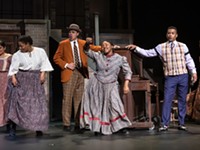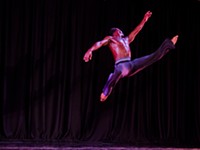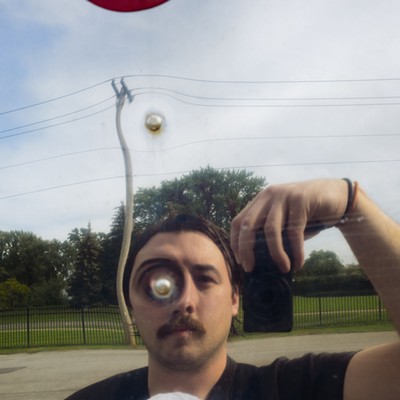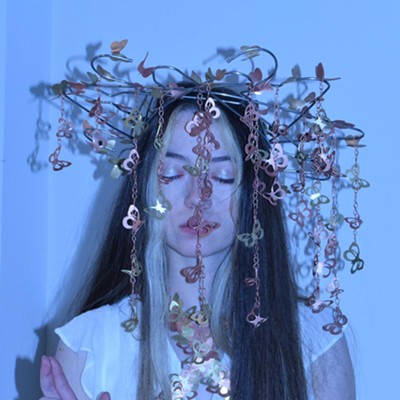[
{
"name": "500x250 Ad",
"insertPoint": "5",
"component": "15667920",
"parentWrapperClass": "",
"requiredCountToDisplay": "1"
}
]
Bill Viola's high definition video series, "Martyrs," is the latest exhibit in the Memorial Art Gallery's Media Arts Watch program. In the darkened room dedicated to the program, four narrow, flat-screen monitors surround the viewer, each installed on one of the four walls. Brief, bright dramas play out in sync, requiring the viewer to continuously spin around to follow the progression as four individuals calmly endure elemental torture.
On the screens, one man is dragged upward by a rope tied around his ankles as water cascades over him; a woman bound at wrists and ankles is stretched vertically, rack-like in the mid-air, and buffeted by strong winds; a seated man calmly regards the viewer while flames drop around him and eventually engulf him; and in a plot twist, a man is un-buried alive by earth that floats upward and slowly he stands.
Provided info states that the work was originally commissioned by London's St. Paul's Cathedral, and that the root, Greek word for martyr means "witness."
"In today's world, the mass media turns us all into witnesses to the suffering of others," Viola writes. "The martyrs' past lives of action can help illuminate our modern lives of inaction."
The work's unwavering gaze at the body and mind's ability to gracefully endure pain — and the certainty of death — is engaging. But it's problematic that it's beautiful. And something rings awkwardly about Viola's simultaneous lauding those who have historically suffered and died for a cause while pointing toward modern "inaction." Is that a call to action? What kind of action?
The work seems to ignore the fact that powerful people are still knocking down those who dare to stand. We name avenues for dead heroes while we fail the living ones. When militarized police abuse peaceful protestors, should the crowd film it for the collective audience who already know, or should something more immediate happen? Should we defend ourselves and others, or calmly endure?
"Martyrs" is mesmerizing in a way — it gives the viewer permission to feed the natural, morbid instinct to witness intimations of suffering and death, while not actually displaying any of it on screen. The work is a shadow of reality: There are no visible impacts on the bodies and no wails of pain. There's no fear. There's no struggle.
Viola's work follows a long tradition of spiritually-minded art that anesthetizes or romanticizes torture and murder, asking the viewer to witness and ponder and respect their voiceless suffering but without an entry point to assist. We are absolved of duty.
Again, this work was made for a church. The Christian faith itself preaches turning the other cheek and is (meant to be) based upon the emulation of the most famous martyr of all. From childhood, Christians bear witness to the idea of his suffering and death and are told it happened on their behalf. The problem of martyrdom is that it places the burden and the penalty of standing on an individual. And look at the state of the world.
We should feed the poor, but we had better not discuss dismantling the oppressive systems that guarantee poverty. Talking heads more or less condemn neo-Nazis, but also condemn those who lift a fist to defend the people they target.
While I was viewing the work, several groups of students entered and exited, some showing their discomfort by uttering a low "Whaaaat the fuuuuck?" and fidgeting and cracking jokes.
Their reaction felt similar to real life reactions to being forced to witness abuse and death, while remaining as prone and as accepting as the victims. In many cases when people stand — Kaepernick gently protesting police brutality, a young woman on hunger strike to protest UR President Joel Seligman's response to complaints about Florian Jaeger's sexual harassment — there is meager support but there is many times as much jeering from the audience. The structures of power have made many into doubters and cowards, and the concept of martyrdom upholds the idea that suffering, punishment, and death are the banal effects to taking a stand.
The only actor in the work who showed a pained expression was the man enduring fire, and from what I could tell, he was the only one not actually enduring the element — the flames at the point of engulfing him had to have been digital, as he and his clothing were unscathed. The other actors endured gracefully in their certainty that the pain would end.
This tidy representation of enshrined torture accomplishes little — it doesn't ask anything lasting of the viewer and lets us deify victimhood, while the agents of the oppression get away with it and remain unnamed and unaccountable.
Speaking of...
-

“Ragtime” evokes history through rhythm and rhyme
May 8, 2023 -

Film review: 'Ralph Breaks the Internet'
Nov 27, 2018 - More »
Latest in Art
More by Rebecca Rafferty
-

Beyond folklore
Apr 4, 2024 -

Partnership perks: Public Provisions @ Flour City Bread
Feb 24, 2024 -

Raison d’Art
Feb 19, 2024 - More »





